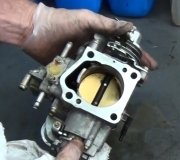Check the ignition timing/vacuum advance unit and clean out the PCV valve and look for vacuum leaks using the method below
A faster technique for finding intake manifold vacuum leaks is to get a bottle of propane and attach a length of rubber hose to the gas valve. Open the valve so you have a steady flow of gas. Then hold the hose near suspected leak points while the engine is idling. If there is a leak, propane will be siphoned in through the leak. The resulting "correction" in the engine's air/fuel ratio should cause a noticeable change in idle speed and/or smoothness (Note: on engines with computerized idle speed control, disconnect the idle speed control motor first).
Aerosol carburetor cleaner can also be used the same way. CAUTION: Solvent is extremely flammable, so do not smoke or use it if there are any sparks in the vicinity (arcing plug wires, for example). Spray the solvent on suspected leak points while the engine is idling. If there is a leak, the solvent will be drawn into the engine and have the same effect as the propane. The idle speed will suddenly change and smooth out.
TIP: If you have a scan tool, look at the Short Term Fuel Trim (STFT) value while you are using carb cleaner or propane to check suspected vacuum leak points. If there is a leak and some of the cleaner or propane is sucked in through the leak, you will see a momentary drop in the STFT reading. This confirms you have found a leak (keep checking because there may be multiple leaks!).
SPONSORED LINKS
Sunday, December 13th, 2009 AT 7:09 PM




